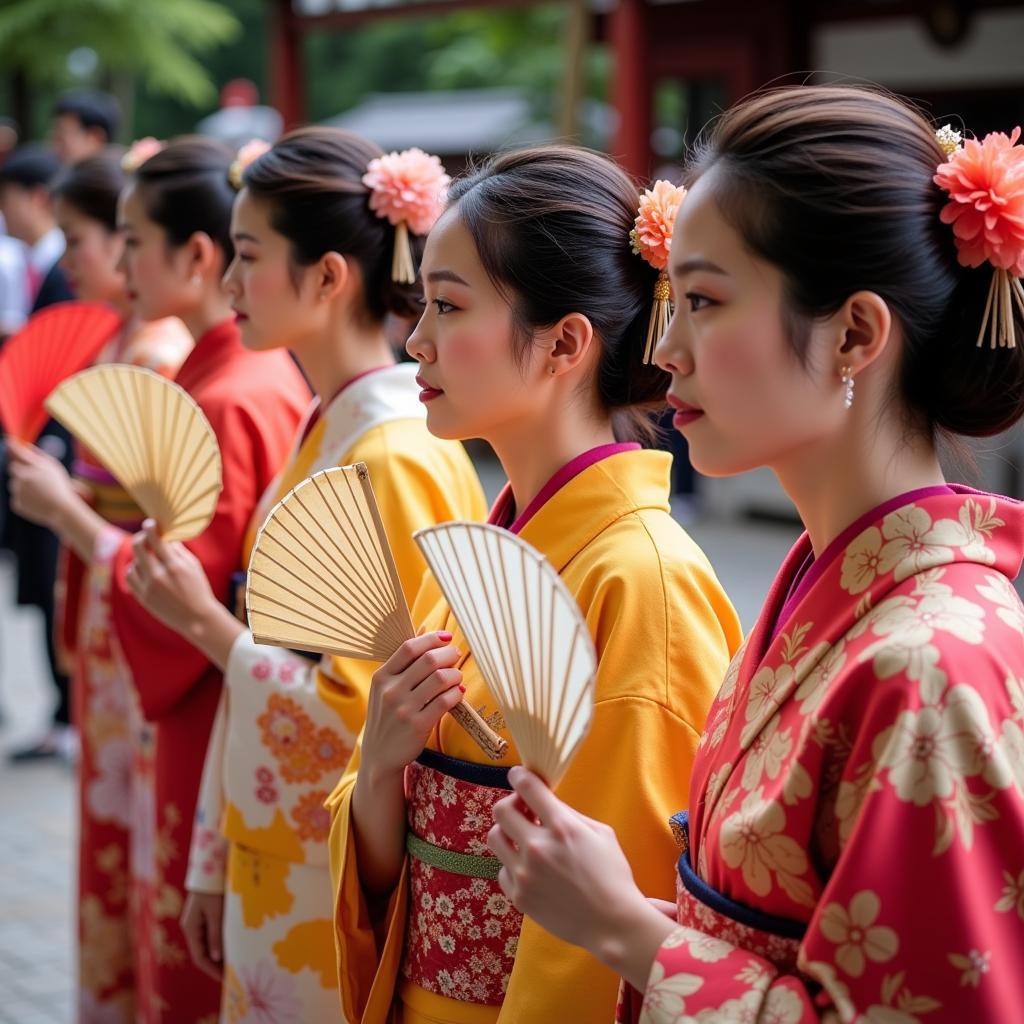The tradition of Japanese Paper Fan Making, known as sensu, dates back centuries and represents a beautiful blend of practicality and artistry. More than just tools to cool oneself, these fans are intricately crafted objects that embody Japanese culture and aesthetics.
A Glimpse into the History of Japanese Fans
The exact origins of the Japanese fan remain shrouded in some mystery, but evidence suggests that fans made from leaves, feathers, and other natural materials were used in Japan as far back as the 6th century. These early fans were likely employed for ceremonial purposes and as status symbols. Over time, the production of fans evolved, with folding fans emerging during the Heian period (794-1185). This period saw the development of the distinctive folding fan structure we recognize today, made possible by innovations in paper making and bamboo processing.
 Historical Timeline of Japanese Folding Fans
Historical Timeline of Japanese Folding Fans
The Craftsmanship Behind Japanese Paper Fans
Creating a Japanese paper fan is a meticulous process that requires both skill and artistry. Here’s a closer look at the key steps involved:
-
Selecting the Materials: The materials used in crafting Japanese fans are carefully chosen for their quality and aesthetic appeal. The fan ribs, traditionally made from bamboo, are selected for their strength, flexibility, and straightness. The paper, often washi (traditional Japanese paper), is chosen for its durability, texture, and ability to hold pigments.
-
Shaping the Ribs: The bamboo ribs are carefully split, planed, and shaped to create the desired fan framework. This process demands precision and a keen eye for detail, ensuring that the ribs are uniform in size and shape.
 Craftsman Shaping Bamboo Ribs for a Japanese Fan
Craftsman Shaping Bamboo Ribs for a Japanese Fan
-
Creating the Fan Face: The fan face, or leaf, is created by carefully adhering thin sheets of washi paper to the assembled bamboo ribs. This process requires a delicate touch and a steady hand to prevent wrinkles or tears.
-
Decorating the Fan: Once the fan face is complete, it is then decorated using a variety of techniques. These may include painting, calligraphy, embroidery, or the application of gold leaf. The designs featured on Japanese fans are often inspired by nature, literature, or historical events, adding another layer of meaning and beauty to these objects.
The Cultural Significance of Japanese Fans
Japanese paper fans hold significant cultural importance. They are not merely objects of utility but also symbols of tradition, art, and social customs.
-
Ceremonial Use: Fans have long played a role in Japanese ceremonies. For instance, they are used in traditional dances, tea ceremonies, and Noh theater. In these contexts, the fans become extensions of the performers’ movements and expressions, conveying emotions and enhancing the narrative.
-
Gift Giving: Japanese paper fans make thoughtful and symbolic gifts. They can represent wishes for good luck, prosperity, or happiness, making them appropriate for various occasions.
 Women in Traditional Kimonos Holding Japanese Fans During a Ceremony
Women in Traditional Kimonos Holding Japanese Fans During a Ceremony
Modern Interpretations and Uses
While the traditional methods of Japanese paper fan making are still honored and preserved, contemporary artists and craftspeople continue to explore new and innovative ways to interpret this ancient art form.
-
Contemporary Designs: Modern Japanese paper fans often feature contemporary designs and patterns, reflecting current artistic trends and individual expression.
-
Home Decor: Japanese paper fans have become popular decorative items in homes and businesses. They add a touch of elegance and cultural flair to interior spaces.
-
Fashion Accessories: Some designers have incorporated Japanese paper fans into their fashion creations, using them as unique and eye-catching accessories.
Conclusion
The art of Japanese paper fan making continues to captivate and inspire, bridging the gap between tradition and modernity. From their humble beginnings as practical tools to their elevated status as objects of art and cultural symbols, Japanese paper fans offer a fascinating glimpse into the rich heritage and creative spirit of Japan. Whether cherished as decorative pieces, used in traditional ceremonies, or gifted as tokens of good fortune, these delicate creations continue to hold a special place in Japanese culture and beyond.
FAQs about Japanese Paper Fans
1. What are Japanese fans called?
Japanese fans are known as sensu (扇子). This term encompasses various types of fans, including the folding fan (ōgi) and the rigid fan (uchiwa).
2. What is the significance of the number of ribs in a Japanese fan?
The number of ribs in a Japanese fan can hold symbolic meaning. For instance, fans with an odd number of ribs are sometimes associated with good luck. However, it’s essential to remember that interpretations can vary depending on context and regional customs.
3. Are Japanese paper fans fragile?
While Japanese paper fans are delicate and require careful handling, they are generally more durable than they appear. The washi paper used in their construction is known for its strength and flexibility.
For further insights into the world of Japanese fans, you might be interested in exploring related topics such as fan leaf in japan and folding fan parts.
Need Assistance?
Contact us at Phone Number: 0903426737, Email: fansbongda@gmail.com or visit us at Address: Lot 9, Area 6, Gieng Day Ward, Ha Long City, Gieng Day, Ha Long, Quang Ninh, Vietnam. Our customer support team is available 24/7.


